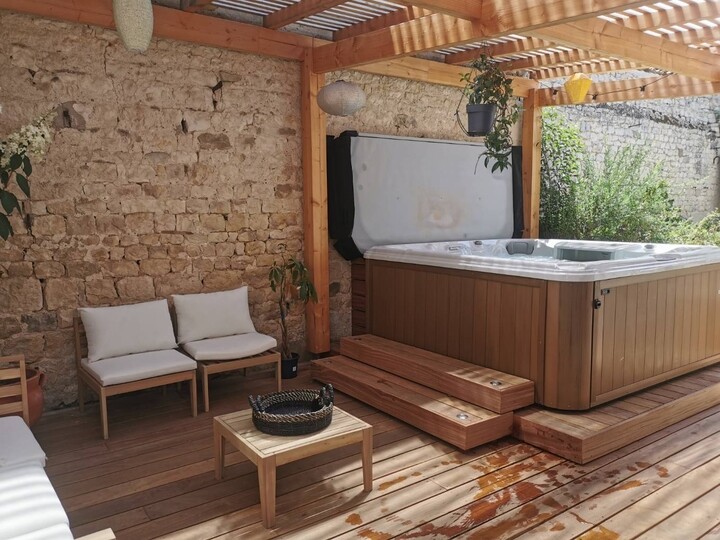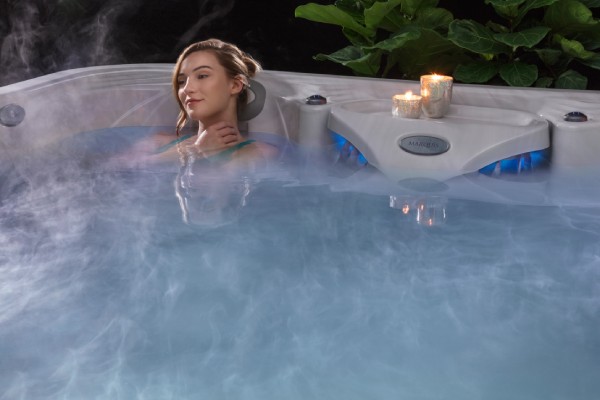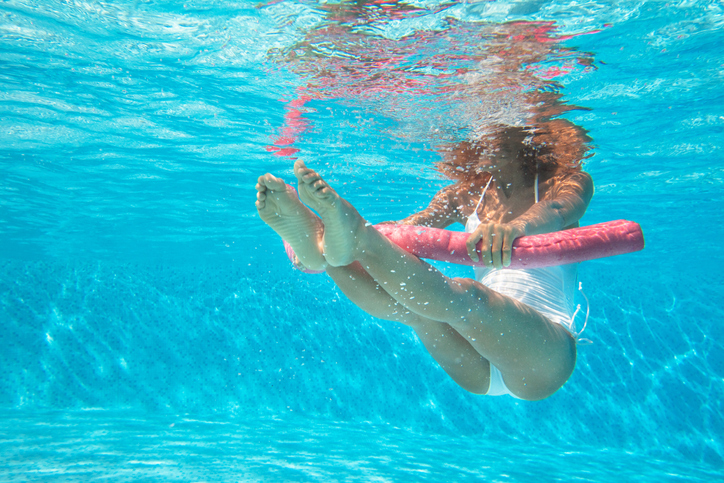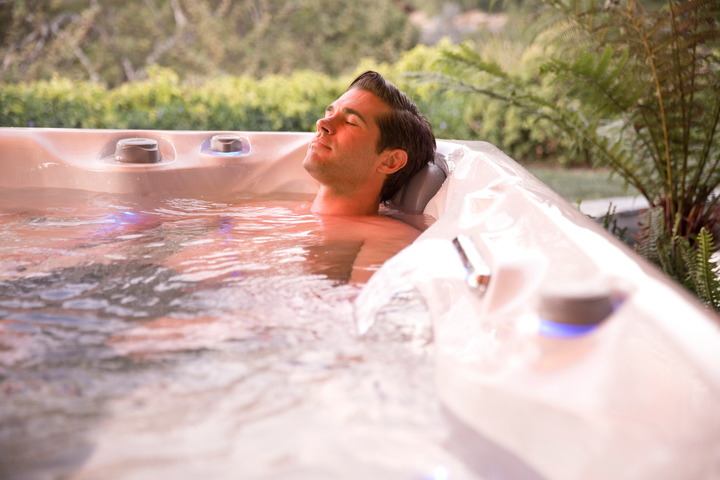Taking care of your hot tub is a huge responsibility. It isn’t just about soaking in it whenever you want some downtime — you have to know how to clean it, drain it, and refill it properly.
Why? So you can properly care for it, of course! There’s more to it than just wiping it down with a cleaner. Before you start changing your spa water, you have to know how to remove buildup while maintaining its surface. But the good thing is, if you’re not sure how to do it, we’ve got you covered.
The Importance of Draining Your Hot Tub
So, why is it important to drain your hot tub? Well, the same water sits in your hot tub for months at a time, and if you’re not regularly sanitizing it and shocking it (we’ll get into this later), you’re basically soaking in the same overused water. Eventually, you’ll have to drain your hot tub and refresh the water.
Think about it this way. Each time you use your hot tub, different contaminants enter the water, such as:
- Sweat
- Lotions
- Cosmetics
- Bodily residue
- Body oils
- Hair products
- Dirt
And if you have friends or family over that also use your hot tub, you’re looking at a large number of contaminants in your water. But even more, those contaminants don’t just stay in the water; they pass through the filter and plumbing too. Although the filter can pick up most of it, the rest will go through and create bacteria in the pipes, creating a layer of biofilm.
Biofilm is small amounts of bacteria and fungi that get stuck in your hot tub’s pipes. What’s so interesting about biofilm is that it’s immune to the chemical that will fight it — chlorine. Therefore, the biofilm will then build a barrier around itself. So as you continue to use your tub without draining it, more and more biofilm will begin to stick inside your plumbing, impeding your water flow and filter efficiency. But don’t worry, there’s a way to get rid of it.
When and How Often Should You Drain and Clean Your Hot Tub?
When do you know that it’s time to clean your spa? There are a few signs that’ll signal that it’s time for a drain and clean.
These signs can include:
- Your hot tub has a foul odor
- No matter what you do, the water won’t clear
- You’ve had guests in your hot tub
- You’ve been using your hot tub more frequently
- Your hot tub hasn’t been used in a long time
If any of these apply to you, it’s time to get started.
Now, how often should you drain and clean your hot tub? Even if only one of the earlier conditions applies, a good rule of thumb is to drain and clean it quarterly. It’s best to prevent any issues before they arise, so it’s good to have a consistent cleaning schedule. Considering how easily biofilm builds up, regular maintenance will keep your pipes clear, leading to a safer and cleaner experience.
How to Drain Your Hot Tub
Before you begin cleaning your spa, you have to drain the water first. This can be a pretty lengthy process, so we’ve outlined clear steps to help.
Flush Your Lines
Before draining your hot tub, you’re going to need some plumbing cleaner, also called a line flush product. This is a special cleaner that will effectively break down biofilm and other contaminants. Follow the instructions on the back of whichever brand you buy, and make sure you use the appropriate amount for your hot tub’s volume.
Then, allow the cleaner to circulate around your hot tub for a minimum of 20 minutes. However, if this is your first time cleaning your hot tub, it’s best to allow the cleaner to circulate longer — either for a few hours or even overnight. Use the best judgment based on your hot tub.
Now, you may notice that as the plumbing cleaner circulates, it’ll cause a nasty-looking foam to surface on the top of the water. Don’t fret — that’s a good thing! The plumbing cleaner is doing its job of pulling all the biofilm out of the pipes. Since you’ll be cleaning your tub afterward, don’t worry so much about the foam.
Use a Sump Pump
Say you’re in a hurry and don’t have the time or the patience to wait for the plumbing cleaner to work. You can use a sump pump, which is a submersible pump that can empty your hot tub in minutes.
Since it drains your tub in a short amount of time, you’ll need to keep an eye on the water. If the pump continues to run once the water is gone, you could run the risk of burning up the motor.
Where To Drain the Water
Most cities have laws that require you to drain the water into the sewer system. Usually, cities with these laws have sewer access through a particular drain on your property.
If you don’t have direct sewer access, you can drain the water into a utility sink in your home through a hose or dispose of the water on your lawn.
Note: Before draining your spa, ensure you’re adhering to your city’s ordinances and preventing any damage to the environment.
How to Clean Your Hot Tub
Now that you’ve drained your hot tub, you can start the process of cleaning it.
Clean and Replace the Filter
You can actually clean the filter while the water is draining from your hot tub. To clean it, you’ll need either a special filter cleaning spray or a hot tub filter soak. If you want to do a general clean of your filter, the cleaning spray will do the trick. However, if you’re going to deep clean your filter, you’ll need the hot tub filter soak.
Get a 5-gallon (20-litre) bucket and fill it with water. Then, add the hot tub filter soak per the instructions and submerge the filter. Leave the filter inside the soak for 24 hours.
After the 24 hours have passed, and you notice that your filter is still dirty, it’s time for a new filter. Replace your current one, and make a note to clean your filter more often. As a general rule of thumb, you should aim to replace your hot tub filter about once a year.
Note: Be sure to rinse your filter thoroughly with clean water after using a cleaning product. Any leftover cleaner might cause foaming.
Clean the Hot Tub Surface
Now it’s time for surface cleaning.
- Spray your hot tub down with hot tub cleaner. Make sure to focus on the nooks and crannies where mildew and bacteria could be hiding.
- Wipe down the surface with a soft cloth or non-scratch nylon scrubber to remove dirt and grease.
- Be sure to rinse the surface well and drain the rinse water to prevent foaming once you refill your spa again.
- Check and make sure that all the hot tub jets are open once you’re done cleaning and rinsing. This will help reduce the risk of water pressure problems from trapped air.
How to Refill Your Hot Tub
By now, your hot tub should be squeaky clean! Before you refill your hot tub, be sure to close the drains and break out your hose. Also, make sure that your breaker is off too.
Tip: To ensure clean and fresh water, use a hose filter to remove any impurities that may affect your water chemistry and overall hot tub health. This will encourage higher-quality water and prevent the risk of mineral deposit buildup.
Now, let’s get into the refill process.
- Insert the hose into the filter compartment, and turn on the spigot or faucet. This will prevent hot tub airlock and force any trapped air out of your circulation system. Try not to overfill it — it may cause serious problems, such as backflow into your heater when you start up your hot tub. If you happen to overfill accidentally, drain the excess water immediately.
- Turn your spa breaker back on.
- Startup your hot tub, which includes adding sanitizer and other startup chemicals.
- If you have air valves, turn them off. They can disrupt chemical distribution.
- If you have well water or even city water with high metal content, use a metal sequestrant to help prevent stains in your hot tub. Using the hose filter can reduce the risk of stains, but if you’ve had metal-related staining problems in the past, metal sequestrant can help.
- Test the water. Adjust the pH, alkalinity, and calcium hardness if necessary.
- Cover your spa for 24 hours to allow the chemicals to penetrate and mix. Heat the water to at least 80°F (27°C), but no higher than 104°F (40°C).
- Be sure to retest the water when the hot tub reaches your desired temperature. Ensure that the water is balanced before anyone uses the spa, and if not, make the changes necessary.
Clean the Hot Tub Cover and Cabinet
If you’re using a hot tub cover, this is a perfect time to clean it as well. After cleaning it, apply a protectant on it to prevent any sun damage.
Also, you can’t forget about the outside of your spa! Your hot tub cabinet can go through a lot, such a splashout, humidity, and sun damage. Take some time to give it a little TLC. Depending on the material of your cabinet, clean it with the appropriate cleaner. Since most cabinets are made from wood, a gentle wood cleaner and a soft cloth should suffice. After a good clean, apply a layer of protectant with a UV shield.
Before cleaning your hot tub cover or cabinet, be sure to verify the quality and effectiveness of the product you are considering first with the experts at your local spa store. Our team at National Pools & Spas would be more than happy to discuss your spa cleaning needs over the phone or in person at one of our three New Jersey showrooms.
Frequently Asked Questions About Hot Tub Maintenance
To help further, we’ve included an FAQ section for the most asked questions about hot tub maintenance.
What is hot tub shock?
Hot tub shock is a large dose of oxidizer that “shocks” your water into a clean state after contamination.
How do I test the pH of my hot tub water?
You can use test strips or a liquid test kit to measure how acidic or basic your hot tub water. The ideal pH should be between 7.4 and 7.6.
What should my hot tub temperature be?
According to the Centers for Disease Control and Prevention (CDC), 104 F (40 C). However, if your body reaches or exceeds 103 F (39 C), you can develop several conditions related to hyperthermia, such as heat rash, heat cramps, heatstroke, and heat exhaustion.
What’s the difference between chlorine and bromine sanitizer?
Chlorine oxidizes contaminants while bromine ionizes contaminants. Chlorine kills contaminants more quickly than bromine, while bromine kills more slowly. However, chlorine dissipates more quickly than bromine, meaning that it has to be replaced more often. Bromine kills bacteria in your hot tub longer than chlorine does. In terms of safety, chlorine can be harsh on the skin, hair, and eyes, while bromine is a lot gentler on your skin.
Learn More with National Pools & Spas
That’s it for cleaning, draining, and refilling your hot tub! As you now know, it’s no easy task, and it’s not as simple as it seems. But, we hope this article provided all the necessary information you need to take care of your hot tub properly. The first few times cleaning your hot tub may be tough, but the more you do it, the better for you and anyone else using your hot tub.
If you found the information in this article helpful, good news! We have a dedicated blog with more articles like these to help with hot tub maintenance.
Ready to schedule your next hot tub maintenance appointment? Look no further; our experts at National Pools & Spas are just who you’re looking for professional, top-quality hot tub maintenance.
Need to find a new hot tub for your lifestyle? We’re more than happy to help you browse our selection of hot tubs that’ll have all the features you’re looking for. Get in touch with us today!





